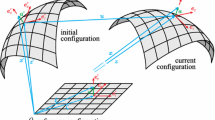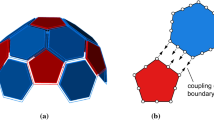Abstract
Numerical simulations of wrinkling and slacking of geometrically nonlinear membrane structures are considered using planar Cosserat points. The finite element method (FEM) solves the problem by weakly projecting the governing PDEs and thus requires numerical integration. This is contrasted with Cosserat point elements wherein governing equations are solved in an averaged sense at a point. The point is equipped with a few directors and can describe the deformation kinematics of a finite region containing itself. Numerical modeling through the Cosserat point provides freedom from numerical integration and locking. Presently a plane stress quadrilateral Cosserat point element is used to study the wrinkling and slacking of isotropic membranes. The approach by Roddeman et al. (ASME J Appl Mech 54:884–892, 1987) is exploited to detect wrinkled/slack elements in the membrane structure. Here stretching parameters are employed to modify the deformation tensor to represent a fictive non-wrinkled surface. A variation of the algorithm to detect spatial variations of the stretching parameters within a point element is also described. Several numerical examples on static deformations of wrinkled/slack membranes are presented. Limited comparisons with a reported experiment and with results via the FEM as well as a mesh-free approach are provided to assess the performance of the approach.
Similar content being viewed by others
Abbreviations
- b i :
-
ith director couple corresponding to body force
- f i :
-
ith external director couple
- σ1, σ2:
-
principal Cauchy stresses
- T1 ,T2:
-
principal Cosserat stresses
- \({\overline {\bf F}}\) :
-
auxiliary deformation gradient
- F :
-
Cosserat deformation gradient
- F * :
-
3D deformation gradient
- σ avg :
-
average Cauchy stress tensor
- σ :
-
Cauchy stress tensor
- d 1/2 T :
-
Cosserat stress tensor
- Π:
-
homogeneous part of the strain energy
- Ψ :
-
inhomogeneous part of the strain energy
- β i :
-
ith inhomogeneous strain corresponding to the ith director
- t i :
-
ith intrinsic director couple
- Φ :
-
total strain energy
- γ1 ,γ2:
-
stretching (wrinkliness) parameters
- E, μ , ν :
-
Young’s modulus, shear modulus and Poisson’s ratio
- K1 ,K2 ,K3:
-
inhomogeneous constitutive constants
- \({\overline {\bf t}^i,\overline {\bf f}^i,\overline {\bf b}^i}\) :
-
ith nodal quantity corresponding to t, f, b
- θ1, θ2, θ3:
-
locally convected curvilinear coordinates
- \({\kappa_1^1 ,\kappa_1^2 ,\kappa_1^3}\) :
-
normalized inhomogeneous strain measures
- \({\overline{\bf D}_{\rm i},\overline {\bf d}_{\rm i} }\) :
-
ith nodal deformed and deformed position vectors
- A:
-
transformation matrix
- D0, D:
-
initial and final thicknesses of the membrane element
- Di, di:
-
ith undeformed and deformed contravariant director vector
- D i , d i :
-
ith undeformed and deformed covariant director vectors
- E :
-
homogeneous strain measure
- G i , g i :
-
ith undeformed and deformed base vectors
- H, L:
-
width and length of the planar Cosserat point
- K :
-
constitutive tensor
- m :
-
mass of the Cosserat point
- n1, n2:
-
unit vectors representing principal stress directions
- \({{\bf n^*}_{1}, {\bf n^*}_{2}}\) :
-
unit vectors representing principal stress directions in 3D setup
- N 3 :
-
unit surface normal
- V, v:
-
volumes of the Cosserat point in undeformed and deformed states
- X, x :
-
undeformed and deformed position vectors of a material point
References
Boerner EFI, Loehnert S, Wriggers P (2007) A new finite element based on the theory of a Cosserat point extension to initially distorted elements for 2D plane strain. Int J Numer Methods Eng 71(4): 454–472
Epstein M, Forcinito Mario A (2001) Anisotropic membrane wrinkling: theory and analysis. Int J Solids Struct 38: 5253–5272
Green AE, Naghdi PM (1991) A thermomechanical theory of a Cosserat point with application to composite materials. Q J Mech Appl Math 44: 335–355
Green AE, Naghdi PM, Wenner ML (1974a) On the theory of rods. Part I. Derivations from the three-dimensional equations. Proc R Soc Lond A 337: 451–483
Green AE, Naghdi PM, Wenner ML (1974b) On the theory of rods. Part II. Developments by direct approach. Proc R Soc Lond A 337: 485–507
Lu K, Accorsi M, Leonard J (2001) Finite element analysis of membrane wrinkling. Int J Numer Methods Eng 50: 1017–1038
Kang S, Im S (1997) Finite element analysis of wrinkling membranes. ASME J Appl Mech 64: 263–269
Kang S, Im S (1999) Finite element analysis of dynamic response of wrinkling membranes. Comput Methods Appl Mech Eng 173: 227–240
Loehnert S, Boerner EFI, Rubin MB, Wriggers P (2005) Response of a nonlinear elastic general Cosserat brick element in simulations typically exhibiting locking and hourglassing. Comput Mech 36: 255–265
Mansfield EH (1968) Tension field theory: a new approach which shows its duality with inextensional theory. In: Proc. XII Int. Cong. Appl. Mech., pp 305–320
Mansfield EH (1970) Load transfer via a wrinkled membrane. Proc R Soc Lond A 316: 269–289
Miller RK, Hedgepeth JM, Weingarten VI, Das P, Kahyai S (1985) Finite element analysis of partly wrinkled membranes. Comput Struct 20: 631–639
Miyamura T (2000) Wrinkling on stretched circular membrane under in-plane torsion: bifurcation analyses and experiments. Eng Struct 23: 1407–1425
Miyazaki Y (2005) Wrinkle/slack model and finite element dynamics of membrane. Int J Num Methods Eng 66(7): 1179–1209
Nadler B, Rubin MB (2003a) A new 3-D finite element for nonlinear elasticity using the theory of a Cosserat point. Int J Solids Struct 40: 4585–4614
Nadler B, Rubin MB (2003b) Determination of hourglass coefficients in the theory of a Cosserat point for nonlinear elastic beams. Int J Solids Struct 40: 6163–6188
Naghdi PM (1972) The theory of plates and shells. In: Truesdell C(eds) S. Flugge’s Handbuch der Physik, vol. VIa/2. Springer, Berlin, pp 425–640
Pipkin AC (1986) The relaxed energy density for isotropic elastic membrane. IMA J Appl Math 36: 85–99
Raible T, Tegeler K, Löhnert S, Wriggers P (2005) Development of a wrinkling algorithm for orthotropic membrane materials. Comput Methods Appl Mech Eng 194: 2550–2568
Roddeman DG, Drukker J, Oomens CWJ, Janssen JD (1987) The wrinkling of thin membranes. Part I. Theory. Part II. Numerical analysis. ASME J Appl Mech 54: 884–892
Rubin MB (1985b) On the numerical solution of one dimensional continuum problems using the theory of a Cosserat point. ASME J Appl Mech 52: 373–378
Rubin MB (1985a) On the theory of Cosserat point and its application to the numerical solution of continuum problems. ASME J Appl Mech 52: 368–372
Rubin MB (2000) Cosserat theories: shells, rods and points. In: Solid mechanics and its applications, vol 79. Kluwer, The Netherlands
Rubin MB (1995) Numerical solution of two- and three-dimensional thermomechanical problems using the theory of a Cosserat point, J. of Math. and Physics (ZAMP) 46, Special Issue, S308-S334. In: Casey J, Crochet MJ (eds) Theoretical, experimental, and numerical contributions to the mechanics of fluids and solids. Brikhauser Verlag, Basel
Shaw A, Roy D (2007a) A NURBS-based error reproducing Kernel method with applications in solid mechanics. Comput Mech 40(1): 127–148
Shaw A, Roy D (2007b) Improved procedures for static and dynamic analyses of wrinkled membranes. ASME J Appl Mech 74(3): 590–594
Shaw A, Roy D (2007c) Analyses of wrinkled and slack membranes through an error reproducing mesh-free method. Int J Solids Struct 44(11–12): 3939–3972
Stanuszek M (2003) FE analysis of large deformations of membranes with wrinkling. Finite Elements Anal Des 39: 599–618
Stein M, Hedgepeth JM (1961) Analysis of partly wrinkled membranes. Tech. Rep. NASA TN D-813
Wagner H (1929) Flat sheet metal girder with very thin metal web. In Zeitschriftfür Flugtechnik und Motorluftschiffahrt, 20
Wu CH (1978) Nonlinear wrinkling of nonlinear membranes of revolution. ASME J Appl Mech 45: 533–538
Author information
Authors and Affiliations
Corresponding author
Rights and permissions
About this article
Cite this article
Banerjee, B., Shaw, A. & Roy, D. The theory of Cosserat points applied to the analyses of wrinkled and slack membranes. Comput Mech 43, 415–429 (2009). https://doi.org/10.1007/s00466-008-0314-y
Received:
Accepted:
Published:
Issue Date:
DOI: https://doi.org/10.1007/s00466-008-0314-y




